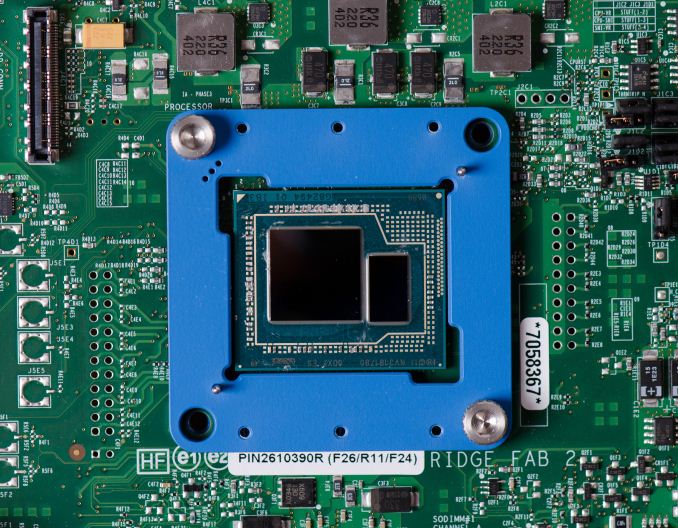Intel Xeon to get Crystal Well: E3-1284L v3
by Ian Cutress on March 10, 2014 7:44 AM EST- Posted in
- CPUs
- Intel
- Xeon
- Iris
- Crystal Well

At both the Intel Haswell launch and the first shipping Haswell Xeon silicon, I lamented the lack of a Crystal Well Xeon part in the line-up. It would make sense that a large L4 cache on a CPU would be a prime target for workstation and server applications, as well as the gaming methodology used by Crystal Well in the Mac/Clevo laptops and Brix Pro system. Thus when searching for information on Xeon E3 SKUs today, my surprise came at the listing of Iris Pro 5200 enabled Xeon silicon.
Slipping somewhat under the radar, the Xeon E3-1284L v3 is a BGA only processor, featuring lower frequencies than any other Crystal Well SKU to date. The 47W quad-core part has a base clock of 1.8 GHz, hitting 3.2 GHz as the max turbo frequency. That is a big jump from base to turbo, so it would be interesting to see what the breakdown turbo frequencies are depending on per-core loading. As with the other similar SKUs, we have 32GB DDR3-1600 support, however ECC is supported and the memory bandwidth comparison on ark.intel.com would make this component aimed more for laptops and mobile devices rather than desktops. The integrated Iris Pro 5200 graphics have the highest base frequency of any Iris Pro part at 750 MHz, rising to 1.0 GHz at turbo which is incidentally the lowest turbo frequency of the Iris Pro 5200 range. vPro, VT-x, VT-d and TSX-NI are all enabled for this part as well.
Both CPU-World and ark.intel put the release of this part at Q1’14 (CPU-World states February 2014), however much like the initial Crystal Well parts, I would imagine we were 6 months out from seeing any products with the CPU coming to market. It could turn out that this SKU is just a specific customer’s request – it would seem a little odd just to have one processor of this nature in the Xeon line-up. But if your volume is sufficient, Intel might make it just for you.
Anand, Ganesh and I have each taken four separate looks at different Crystal Well hardware, including Intel’s Customer Reference Board, the iMac, a Clevo and the GIGABYTE Brix Pro.










35 Comments
View All Comments
Kevin G - Monday, March 10, 2014 - link
For Knights Landing, Intel has stripped out the GPU functionality. Rather it is a play towards extreme bandwidth considering the ultra high core count involved. Similarly, Haswell-e is likely going to reach 18 cores on the EX part. With the EX line still using FB-DIMM like buffers, the addition of eDRAM would help with any latency penalty due to the buffers. (An alternative would be to put the eDRAM into the memory buffers like IBM has done with the POWER8.)MrSpadge - Tuesday, March 11, 2014 - link
You don't need a GPU to benefit from Crystalwell. A GPU shows the highest gains from it.. but is still remaining in "rather irrelevant" territory. Unlike a possible 0 - 30 % performance boost per clock for e.g. an i7 4770K.tipoo - Monday, March 10, 2014 - link
It will be very interesting to see what that huge L4 cache can do for the more professional/heavy use side of things like servers.extide - Monday, March 10, 2014 - link
I wonder if this might end up in a Dell Prescision/HP ElieteBook laptop... That could be pretty sweet!twotwotwo - Monday, March 10, 2014 - link
Fascinating, but hard to guess the use case for low TDP + graphics in a server chip, even with the shiny L4 boost. Servers running virtual desktops? Xserve 2014 edition? :-)Kevin G - Monday, March 10, 2014 - link
There are a handful of HPC scenarios where this would advantageous. The eDRAM, TSX and coherent memory space with the CPU + GPU should be popular in the development circles even though ultimate performance of a node is rather lacking. Put a chip like this into a SeaMicro or HP's Project Moonshot system and performance can easily scale up by rapidly increasing node code. Overall compute density should be similar to popular dual LGA 2011 Xeon + PCI-e GPU setup today.Outside of HPC, there are several clustered applications like Hadoop and Casandra that benefit from having many small, fast individual nodes.
Kevin G - Monday, March 10, 2014 - link
At first I had gotten excited but with this being a BGA part, it was all lost. Still hoping for a socket 1150 based part. Otherwise, this part is just another laptop part but with ECC enabled to carry the Xeon name.dolphinboy150 - Monday, March 10, 2014 - link
According to Intel Ark, the Crystalwell BGA parts have more pins:http://ark.intel.com/products/76086
Sockets supported: FCBGA1364
As to what all those extra pins are for isn't clear tho.
DanNeely - Monday, March 10, 2014 - link
Some is probably power related. The BGA1164 parts are limited to a max 28W TDP. They're also limited to dual core parts; but other than impacting power needs I don't think that matters for pinout.TiGr1982 - Monday, March 10, 2014 - link
Not gonna happen either, because this L4 version requires 1364 contacts.It is even officially named "Crystall Well" in ARK database, not even "Haswell". This is a different product from LGA1150 by definition, so they won't refit it to LGA1150. Otherwise, this would have happen already. Stop waiting - be realistic. Welcome to Earth.